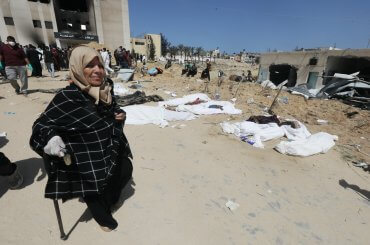In the cool summer evening air of the Jerusalem hills last Tuesday evening, hundreds of Palestinians and Israelis descended on the small village of al-Walaja for a screening of the critically acclaimed documentary Budrus. The screening was jointly organized by Israelis and Palestinians who are working to non-violently resist the construction of Israel’s separation barrier on the village’s land.The screening bore special significance for the people of al-Walaja as the film follows the story of a West Bank village’s unarmed struggle against the construction of Israel’s separation barrier on its farmland and its subsequent success in having the route of the wall changed.
The village of al-Walaja sits between Beit Jala and Jerusalem next to the settlements of Gilo and Har Gilo, both of which have been built on historic al-Walaja land. Since 1967, the village’s boundaries have been shrinking as subsequent Israeli governments have expanded the municipal boundaries of Jerusalem while trying to keep al-Walaja in Palestinian controlled territory. Recently, Israel has started to construct a portion of its separation wall on al-Walaja’s land. The wall will completely surround the village leaving only one entrance to be controlled by an Israeli military checkpoint which will isolate the village from Jerusalem, a main area of employment for many villagers. In some portions, the wall will be as close as five meters from houses of al-Walaja residents. Last Sunday, the Israeli High Court, on appeal from the residents of al-Walaja, decided to request a ‘full explanation’ from the state about the route of the wall. The state has forty five days to explain itself to the court although work is allowed to continue during this time.
On the heels of this important decision, the resemblance between the situation the people of Budrus faced during the time of the film and the threat al-Walaje is facing now made for an emotional screening. Budrus was one of first Palestinian villages to embrace a model of unarmed resistance to the creation of Israel’s separation barrier on its land. Due to the success of this model of resistance other villages such as Bi’lin and Ni’lin have adapted similar tactics in confronting the theft of their valuable land.
During the screening, many in the audience were emotional as images of demonstrations in Budrus flashed before their eyes. Packed in a room of Israelis and Palestinians working together to protect a small village’s land from confiscation by Israel’s separation wall while watching the uplifting story of Budrus, it was hard not to be emotional. A key plot line of the film is the cooperation between Palestinian, Israeli and international in organizing and demonstrating against the wall. These demonstrations, which are documented in the film, often involved harsh Israeli repression in the form tear gas, sound bombs and the use of live fire against unarmed demonstrators.The residents of al-Walaja are accustomed to seeing the same type of violence from the Israeli army during their non-violent demonstrations.
Ayed Morrar, the Palestinian community organizer of Budrus and one of the film’s protagonists, was on hand in al-Walaja for questions after the screening. He appealed to Palestinians to ‘free themselves of traditional thinking’ in adopting new models of non-violent resistance to Israel’s occupation of the West Bank. He argued that Palestinian woman, who make up half of Palestinian society, should play a greater role in organizing and demonstrating in non-violent demonstrations. He noted the similarities between Budrus and al-Walaja in their struggle against the wall and occupation.
Israeli activist, Yotam Wolfe, appealed to the Israeli members of the audience to keep attending the demonstrations in al-Walaja just as Israelis had done in Budrus. He reminded everyone that as Israelis with extreme privilege in society, it is a moral responsibility to help the people of al-Walaja in their struggle. One Israeli, writing on his blog in Hebrew, wrote about returning to Jerusalem after the screening; ‘I returned full of hope and anger, full of anger and pain, full of love…” I believe his statement captures the feeling that all of us had after viewing this incredible film in al-Walaja.

